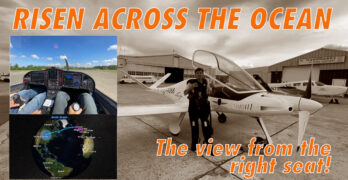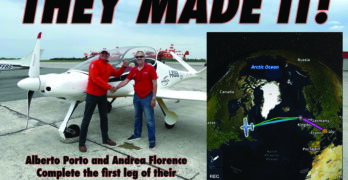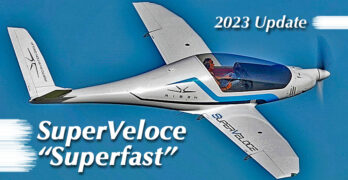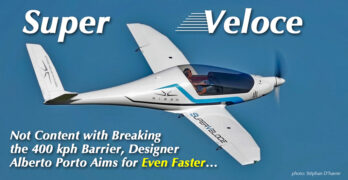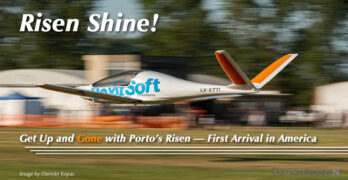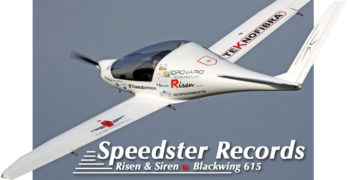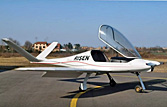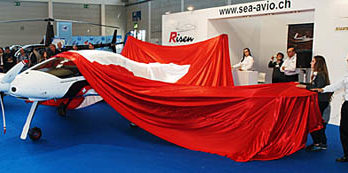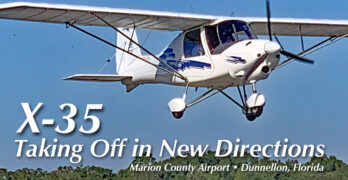We recently reported that the newest version of the sleek, retractable-gear Risen had made a successful transatlantic crossing. From what we could piece together from outside accounts and posts on social media, it went well. But here’s a more first-person look at the crossing, from the perspective of the right seat.
Andrea Venturini accompanied designer Alberto Porto on the epic journey across the pond. Here’s his account.
It all started last December, with a phone call I received from Alberto Porto. At the time, I was in Australia doing a report at the Gliding World Championship for theItalianTeam. Onthephone Alberto, designer and builder of the fastest ultralight in the world (430 kph/232 knots), with the simplicity that always distinguishes him, says: ”Andrea, keep yourself free for next June, I’ll detail everything when you return to Italy.”
You can imagine my curiosity in the meantime. A few weeks later, the mystery was revealed: the Risen Superveloce with the brand new Rotax 916 iS must be brought to Oshkosh, to AirVenture, the largest and the most important aviation fair ‘of the Universe.’ I knew well what Oshkosh meant.
Search Results for : Risen
Not finding exactly what you expected? Try our advanced search option.
Select a manufacturer to go straight to all our content about that manufacturer.
Select an aircraft model to go straight to all our content about that model.
Risen Completes Transatlantic Leg
On June 14, a Porto Aviation’s Risen completed the transatlantic leg of its journey from Milan, Italy, to Oshkosh, Wisconsin. The company posted on social media: “We made it!!! I have been reluctant to post anything here before accomplishing this epic flight , being Italian I guess makes me more superstitious.A page in aviation history has been written by Alberto Porto and Andrea Florence (Venturini). 1900 nautical miles, average speed [of] 165 kts, with just over 43 gallons of fuel!!! We left this morning early in rainy Scotland and landed in the afternoon at Goose Bay the same day without refueling.”
The company announced its cross-the-pond plans this May to bring the newly re-engined Risen to the U.S. While many versions of the retractable-gear Risen use the Rotax 912, the company had been fitting the turbocharged 915 iS. But this example has the newer, more powerful Rotax 916 iS.
Risen Group Plans Transatlantic Flight to OSH
You’ve heard of the Risen, Alberto Porto’s sleek, fast retractable that makes the most of its Rotax 912 power. With more than 180 mph on tap with the 912 iS, the Risen seems the perfect two-person traveling machine. It’s also one, like the Sparker, that would fit well into the new MOSAIC rules.
Well, Porto and Andrea Venturini are going to find out just how well it travels this summer. They’ve announced a “unique, record breaking flight across the Atlantic Ocean.” Only this Risen will be using the latest Rotax 916 iS, the turbocharged, 160-hp engine so many airframers are now fitting in place of the 915 iS.
For Porto and Venturini, “the plan is to cover 3200 kms or about 2000 statute miles across the Atlantic Ocean with a fuel consumption of just over 50 gallons of fuel at speeds up to 230 mph.
Streaking through the Sky — Speedy Risen Continues our Top-50 Aircraft Series
When this series started, Icon’s shapely A5 LSA seaplane topped the list. Handsome as it is and like most seaplanes, A5 is not particularly fast. The subject of this second in the series of 50 aircraft is Porto Aviation’s Risen. You might say it is on the other end of the speed spectrum Risen rips!
This one challenges all others in the speed contest for LSA (and later, mLSA).
Our #2 video on Videoman Dave’s immense library has garnered 700,000 views. That’s particularly satisfying as Dave was able to use footage from my first solo video effort.
I was at Aero Friendrichshafen 2015 when Risen made its debut. Videoman Dave was not able to attend that year but I hit it off with developer Alberto Porto and he consented to work with me. I was just learning how to shoot a video so for this one to go over well speaks loudly about how much pilots love Risen.
Warp Speed! — Designer Alberto Porto Says, “Make It So” with Risen SuperVeloce
Most of us would be mighty pleased to sit comfortably and gaze upon our pace-setting aircraft. As reported recently, Alberto Porto, head of Porto Aviation, flew to a higher altitude and managed to squeak past the 400 kilometer per hour (true airspeed) barrier in his supersleek Risen powered by the turbocharged Rotax 914 engine.
Most of us, however, are not Alberto. Apparently, this man does not care to sit idly and admire his past achievements.
When you’ve already designed what may be the fastest LSA-type aircraft in the world, what do you do next?
Shorten Risen’s wing span, install a more powerful engine and go even faster. Duh!
Original Risen wingspan: 29.5 feet — Risen SuperVeloce wingspan: 26.9 feet. How much difference results when span loses 31 inches and power increases 40%? Speed demons want to know.
Can LSA Fly So Fast?
The speed olympics are going on in Europe where authorities do not restrict the velocity of what they call “ultralights” or “microlights.” In the USA, very similar models are called Light-Sport Aircraft, except LSA are trapped by that darn 120 knot speed limit.
Faster and Faster — Porto Aviation’s Risen Eclipses the 400 Kilometer per Hour Barrier
The appeal is obvious. What pilot doesn’t like the idea of flying faster? Even those of us who enjoy low-and-slow Part 103 ultralights remain intrigued by the idea of going fast, eating up the miles en route to a destination. [Article updated 5/31/21 with additional information. —DJ]
Since I first saw this aircraft when it was unveiled to the world at Aero 2015, I have kept my eye on Risen. It was clear this design was going places… literally.
I used a bit of English humor in the lead photo saying “Risen Shine,” meant to play off “Rise and shine,” a get-out-of-bed-and-get-to-work phrase common in the U.S. The truth is, you don’t pronounce it RYE-sen. Porto Aviation Group marketing man Stéphan D’haene clarified that they say REE-sen.
However you may say the name, Risen is one ripping-fast aircraft. Below you’ll read about its latest speed record but Americans may be interested to hear the first example is now tearing up the skies over Montana.
Racing Risen — A “Pandora’s Box” (and Lesson) About Speed Records in Light Aircraft
In our strongest month ever, April 2020, our biggest story was about the Swedish Blackwing “Speed Monster.” Pilots almost universally admire a beautiful and fast aircraft. Blackwing won hearts …and perhaps some orders for the Scanadanavian manufacturer.
Blackwing edged out Risen with its record flight, prompting a representative of Porto Aviation Group to provide a deeper perspective. Many years ago as an active hang glider pilot, I found the records-keeping body, FAI, to be very strict and formal in how it administered world record claims.
Siren or Risen
Whatever the Name; It’s Fast
One of my most popular videos (with well over a half million views and hundreds of comments) is an interview I did with Alberto Porto, developer of Risen. It was 2015 and he had just introduced his speedster He said it would set records and it turns out he knew what he was saying.
Sea-Avio — Risen (high performing Swiss microlight)
One of the most eye-catching microlights at Aero 2015 was the Sea-Avio Risen. This may be the fastest aircraft in the world using a 100-horsepower Rotax 912 ULS. At the show, we were able to interview the developer to get his view of his machine. What you see in the video is the first production model while the prototype has acquired more than 300 hours of flight time. It’s expensive, yes, but man!, does this bird fly fast. Get more detail in this video.
VIDEO — Check Out the Speedy Swiss Risen
In addition to what you can read on ByDanJohnson.com, we have a growing library of videos. When I attend airshows, I frequently hear from attendees that they thoroughly enjoy these 8-12 minute productions. I have the fun job, seeking out airplanes and speaking to the developers behind them while on camera. After that my video partner, Dave, does the big job of editing these things into what I consider to be very nice productions. You get views of the airplane, hear the details, and see more about them than any other way than attending the airshow yourself.
In this newest posted video, you see the gorgeous Risen from Sea-Avio.com (SEA is Swiss Excellence Airplanes). Update June 2020 — SEA is now Porto Aviation Group. Now, this is not simply one more entry in the increasingly crowded Light-Sport or (European) microlight market. This may be the fastest airplane in the fleet and is certainly — if not the fastest — one of the speediest airplanes to use the Rotax 912 ULS engine.
Grassroots Success Story — Dunnellon’s X35 Attracts New, Younger Aviation Businesses
If I’ve heard one lament repeatedly over a long career, it is that current pilots don’t see enough new pilots coming into aviation. Are you one who worries a little or a lot about that? If not, you are a rare pilot.
Is it any wonder, though? The price of aircraft is way, way up. This applies to used aircraft and new — just like it does with your groceries or gasoline. The cost of maintenance is high and rising. Insurance is very expensive (for airplanes as well as cars or houses). Hangars are unavailable with years-long waiting lists at many airports.
More than ever it can seem, aviation is an activity for those with fairly thick wallets. The squeeze on modest budgets has rarely been this demanding.
Yeah, all that, but this website nonetheless discovers the affordable end of aviation. In that pursuit, I was drawn to an airport with an encouraging twist on the affordability squeeze play.
- 1
- 2
- 3
- …
- 5
- Next Page »


